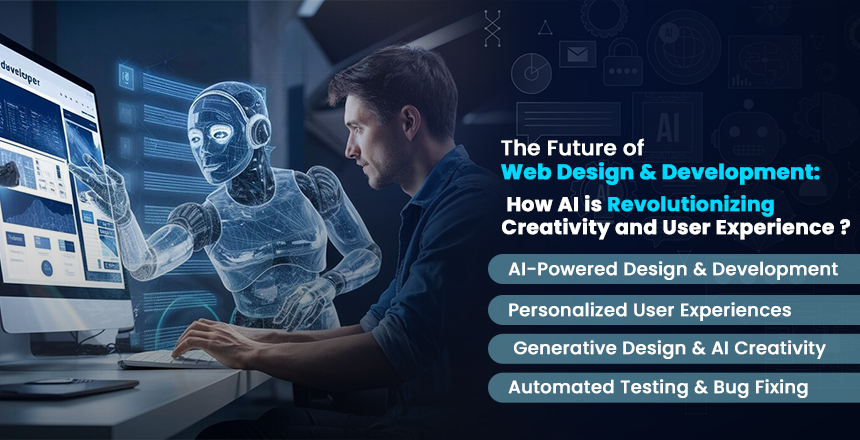The rapid advancements in artificial intelligence (AI) are transforming industries worldwide, and web design and development are no exception. AI is no longer a distant concept but an integral part of how we interact with technology today. As businesses and developers strive to create faster, more efficient, and user-centered websites, AI is revolutionizing both the creative and technical aspects of the web.
This article explores how AI is reshaping the future of web design and development, bringing unprecedented opportunities for creativity and user experience (UX). From AI-driven design tools to intelligent user interfaces, the future of web design is set to be more innovative and user-friendly than ever before.
1. AI-Powered Design Tools: Expanding Creative Boundaries
Creativity and design have traditionally been human-dominated fields. However, AI is now expanding what’s possible by augmenting human creativity with machine learning algorithms. AI-powered design tools, such as Adobe Sensei and Figma’s AI features, are simplifying design processes while allowing designers to explore more innovative approaches.
Automating Repetitive Tasks: AI can handle repetitive and time-consuming design tasks such as resizing images, suggesting layouts, or even choosing color schemes. This allows designers to focus on more creative decisions while maintaining consistency across a project. Tools like Fronty, which can convert a sketch or image into HTML code, are streamlining the transition from design to development.
Generative Design: AI can generate multiple design variations based on specific inputs, such as brand guidelines or user preferences. With this capability, designers can experiment with different concepts quickly and efficiently. Generative AI design tools can also offer real-time feedback, allowing designers to iterate their work at a much faster pace. The result is not only greater creative freedom but also improved design outcomes that are more aligned with user needs and business goals.
AI as a Design Partner: Rather than replacing human designers, AI is evolving to become a collaborative partner. AI design systems can suggest design improvements, optimize layouts for user engagement, and analyze previous projects to inspire future designs. This collaboration between human intuition and AI precision enhances the overall design process, ensuring a balance between creativity and functionality.
Personalized User Experiences with AI
Personalization is key to modern web design, and AI is taking it to new heights. AI algorithms analyze user data to create more personalized and tailored web experiences. This data-driven approach enhances user engagement and satisfaction by delivering relevant content, products, and services.
AI-Driven Personalization: AI can analyze user behavior, preferences, and interactions to deliver personalized content in real-time. For instance, an e-commerce website can suggest products based on browsing history, while a news site can recommend articles based on a user’s reading habits. These personalized experiences improve user satisfaction and encourage users to spend more time on a site.
Chatbots and AI Assistants: AI-powered chatbots and virtual assistants are becoming increasingly common on websites. These intelligent tools provide instant support, answer user questions, and guide users through complex processes. AI assistants can also learn from user interactions, becoming more effective over time at delivering the information or assistance users need. By improving responsiveness and offering 24/7 customer support, AI-driven chatbots enhance the overall user experience.
Predictive UX: AI can also predict what users are likely to do next based on past behaviors, enabling websites to anticipate needs and offer solutions proactively. Predictive UX can enhance e-commerce platforms by suggesting products before users even realize they need them or by auto-completing forms based on prior inputs. This seamless and intuitive experience minimizes friction, making websites more user-friendly and efficient.
AI and Automation in Web Development
In addition to transforming design, AI is also revolutionizing web development by automating coding tasks, streamlining workflows, and making web creation more accessible.
AI-Generated Code: AI-powered tools like GitHub Copilot and DeepCode are capable of generating and suggesting code snippets based on natural language prompts or user input. These tools assist developers by speeding up the coding process, reducing errors, and improving overall code quality. AI-driven development platforms can handle everything from writing simple functions to solving complex coding problems, freeing developers to focus on high-level tasks.
Automated Testing and Debugging: AI can also streamline testing and debugging processes by automatically identifying errors and suggesting fixes. This leads to more reliable and secure websites with fewer bugs and performance issues. By continuously monitoring code, AI can detect potential vulnerabilities or performance bottlenecks, ensuring that the website remains fast, secure, and functional.
No-Code and Low-Code Platforms: AI is enabling the rise of no-code and low-code platforms, which empower users without technical expertise to build websites and applications. These platforms, powered by AI, use visual interfaces and drag-and-drop components to allow users to create websites without writing any code. This democratization of web development opens up new possibilities for businesses and individuals who can now build customized websites faster and at a lower cost.
AI in Web Accessibility
Accessibility is a critical component of web design, ensuring that websites are usable for all individuals, including those with disabilities. AI is playing a crucial role in making the web more accessible by providing tools that automatically enhance usability.
AI-Powered Accessibility Tools: AI can automatically adjust website elements to make them more accessible. For instance, AI tools can analyze a website’s contrast ratios and color schemes to ensure they meet accessibility standards. AI can also generate alternative text for images, making them accessible to visually impaired users who rely on screen readers.
Real-Time Accessibility Audits: AI can continuously monitor a website to ensure it adheres to accessibility guidelines like the Web Content Accessibility Guidelines (WCAG). If the website falls out of compliance, AI can prompt developers to make adjustments or, in some cases, automatically apply fixes. By making accessibility easier to implement and maintain, AI is helping to create a more inclusive web.
AI Voice Interfaces for Accessibility: Voice user interfaces (VUIs) powered by AI are also improving web accessibility. Users with mobility issues or vision impairments can navigate websites using voice commands rather than traditional input methods like a mouse or keyboard. This opens up the web to a wider audience and ensures that everyone can interact with websites efficiently.
AI for Data-Driven Design and UX Optimization
Data is at the heart of web development, and AI excels at processing and analyzing vast amounts of data to deliver actionable insights. By leveraging AI, designers and developers can make data-driven decisions that optimize UX and improve website performance.
A/B Testing with AI: Traditional A/B testing, where different versions of a webpage are tested to see which performs better, can be time-consuming. AI automates this process by continuously analyzing user interactions and testing variations in real-time. AI-driven A/B testing can quickly identify which design elements, call-to-action buttons, or content layouts generate the highest conversions, leading to faster optimizations.
Heatmap Analysis: AI tools can analyze user behavior through heatmaps, showing where users are clicking, scrolling, or spending the most time. This data provides valuable insights into which areas of a webpage are attracting attention and which are being ignored. AI-driven heatmap analysis enables designers to refine their layouts to better align with user behavior.
AI in Content Optimization: AI is also used to optimize website content for better SEO and user engagement. AI can analyze search patterns, user intent, and competitive data to recommend content that is more likely to rank higher on search engines and resonate with users. This data-driven approach to content creation ensures that websites stay relevant and engaging to their target audience.
Conclusion
The future of web design and development is undoubtedly intertwined with the growth of AI. From streamlining the design process to enhancing personalization and accessibility, AI is revolutionizing how websites are created and experienced. As AI continues to evolve, it will push the boundaries of creativity and user experience, offering unprecedented opportunities for innovation.
For businesses and developers, embracing AI-powered tools and strategies will be essential to staying competitive in a rapidly changing digital landscape. AI is not just a technological advancement; it’s a creative revolution that is unlocking new possibilities in web design and development, ultimately reshaping how we interact with the web.










